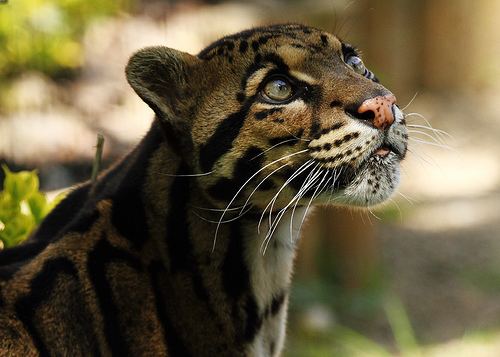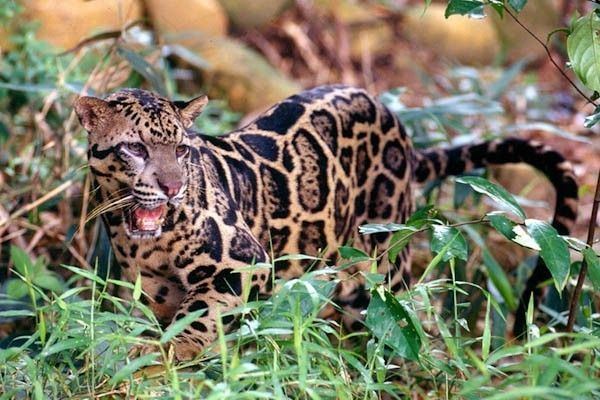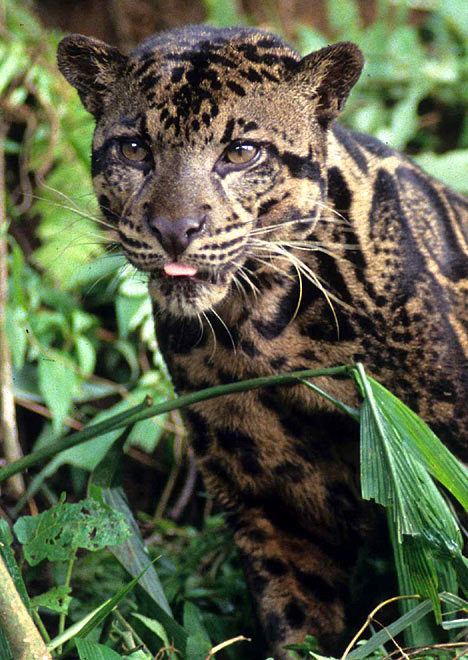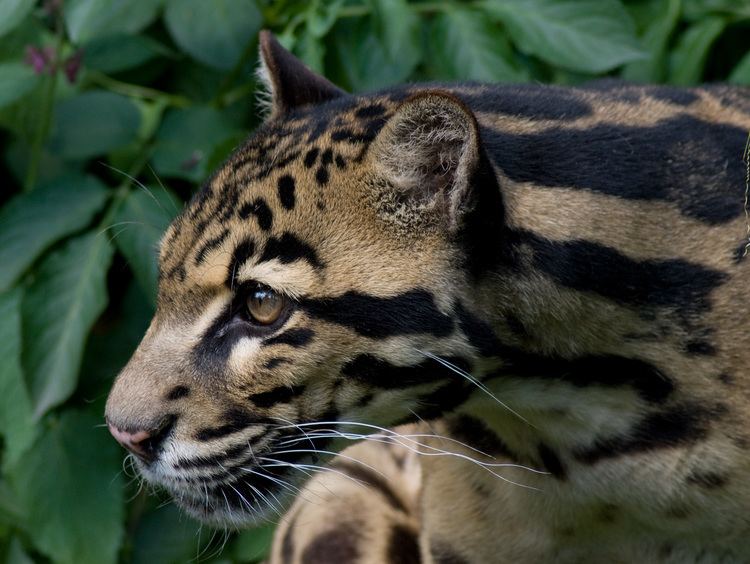Scientific name Neofelis diardi Rank Species | ||
 | ||
Similar Bay cat, Neofelis, Asian golden cat, Kodkod, Clouded leopard | ||
Sunda clouded leopard family group
The Sunda clouded leopard (Neofelis diardi), also known as the Sundaland clouded leopard, is a medium-sized wild cat found in two Indonesian islands of Borneo and Sumatra. In 2006, it was classified as a separate species, distinct from its continental relative Neofelis nebulosa.
Contents
- Sunda clouded leopard family group
- Characteristics
- Distribution and habitat
- Ecology and behaviour
- Evolutionary and taxonomic history
- Threats
- Conservation
- Etymology
- Local names
- References

In 2008, the IUCN classified the species as Vulnerable, with a total effective population size suspected to be fewer than 10,000 mature individuals, and a decreasing population trend.

Previously, the species was known as the Bornean clouded leopard — a name publicised by the WWF in March 2007, quoting Dr. Stephen O'Brien of the U.S. National Cancer Institute as saying, "Genetic research results clearly indicate that the clouded leopard of Borneo should be considered a separate species".

Characteristics

The Sunda clouded leopard is the largest cat in Borneo, and has a stocky build, weighing around 12 to 26 kg (26 to 57 lb). The canine teeth are 2 inches (5.1 cm) long, which, in proportion to the skull length, are longer than those of any other extant cat. Its tail can grow to be as long as its body, aiding balance.

Its coat is marked with irregularly-shaped, dark-edged ovals which are said to be shaped like clouds, hence its common name. Though scientists have known of its existence since the early 19th century, it was positively identified as being a distinct species in its own right in 2006, having long been believed to be a subspecies of the mainland clouded leopard (Neofelis nebulosa).
Distribution and habitat
Sunda clouded leopards are probably restricted to the islands of Borneo and Sumatra in Indonesia. In Borneo, they occur in lowland rainforest, and at lower density, in logged forest. Records in Borneo are below 1,500 m (4,900 ft). In Sumatra, they appear to be more abundant in hilly, montane areas. It is unknown if there are still Sunda clouded leopards on the small Batu Islands close to Sumatra.
Between March and August 2005, tracks of clouded leopards were recorded during field research in the Tabin Wildlife Reserve in Sabah. The population size in the 56 km2 (22 sq mi) research area was estimated to be five individuals, based on a capture-recapture analysis of four confirmed animals differentiated by their tracks. The density was estimated at eight to 17 individuals per 100 km2 (39 sq mi). The population in Sabah is roughly estimated at 1,500–3,200 individuals, with only 275–585 of them living in totally protected reserves that are large enough to hold a long-term viable population of more than 50 individuals.
On Sumatra, Sunda clouded leopards occur most probably in much lower densities than on Borneo. One explanation for this lower density of about 1.29 individuals per 100 km2 (39 sq mi) might be that on Sumatra clouded leopards co-occur sympatrically with the tiger, whereas on Borneo clouded leopards are the largest carnivores.
The first documentary video of a Sundaland clouded leopard was taken in June 2009 by a group of wildlife biologists in Sabah.
Clouded leopard fossils have been found on Java, where it perhaps became extinct in the Holocene.
Ecology and behaviour
The habits of the Sunda clouded leopard are largely unknown because of the animal's secretive nature. It is assumed that it is generally solitary. It hunts mainly on the ground and uses its climbing skills to hide from dangers.
Evolutionary and taxonomic history
The species was named Felis diardi in honor of the French naturalist and explorer Pierre-Médard Diard by Georges Cuvier in 1823, based on a drawing and skin allegedly from Java. In the 19th century Felis diardii designated both clouded and Sunda clouded leopards, colloquially "Diard's Cat".
The Sunda clouded leopard was long regarded as a subspecies of the clouded leopard, and named Neofelis nebulosa diardi. The genetic analysis of hair samples of Neofelis nebulosa and Neofelis diardi implies that they diverged 1.4 million years ago, after having used a now submerged land bridge to reach Borneo and Sumatra from mainland Asia.
Results of a morphometric analysis of the pelages of fifty-seven clouded leopards sampled throughout the genus' wide geographical range indicated that there are two distinct morphological groups, differing primarily in the size of their cloud markings. DNA samples from the Bornean and mainland Asia populations were used in molecular genetic analyses, revealing differences in mtDNA, nuclear DNA sequences, microsatellite and cytogenetic variation. Thirty-six fixed mitochondrial and nuclear nucleotide differences, and 20 microsatellite loci with nonoverlapping allele-size ranges distinguished the populations — a degree of differentiation equivalent to, or greater than, comparable measures among the Panthera species — and strongly support a species-level distinction between Neofelis nebulosa and Neofelis diardi.
In December 2006, the genus Neofelis was reclassified into two distinct species:
Molecular, craniomandibular and dental analysis indicates subspecifical distinction of Bornean and Sumatran clouded leopards into two populations with separate evolutionary histories — a Bornean subspecies Neofelis diardi borneensis and a Sumatran subspecies Neofelis diardi diardi. Both populations are estimated to have diverged from each other during the Middle to Late Pleistocene. The split of Neofelis diardi subspecies corresponds roughly with the catastrophic super-eruption of the Toba Volcano in Sumatra 69,000–77,000 years ago. A probable scenario is that Sunda clouded leopards from Borneo recolonized Sumatra during periods of low sea levels in the Pleistocene, and were later separated from their source population by rising sea levels.
Threats
Sunda clouded leopards being strongly arboreal are forest-dependent, and are increasingly threatened by habitat destruction following deforestation in Indonesia as well as in Malaysia. Since the early 1970s, much of the forest cover has been cleared in southern Sumatra, in particular lowland tropical evergreen forest. Fragmentation of forest stands and agricultural encroachments have rendered wildlife particularly vulnerable to human pressure. Borneo has one of the world's highest deforestation rates. While in the mid-1980s forests still covered nearly three quarters of the island, by 2005 only 52% of Borneo was still forested. Both forests and land make way for human settlement. Illegal trade in wildlife is a widely spread practice.
The population status of Sunda clouded leopards in Sumatra and Borneo has been estimated to decrease due to forest loss, forest conversion, illegal logging, encroachment, and possibly hunting. In Borneo, forest fires pose an additional threat, particularly in Kaltim and in the Sebangau National Park.
There have been reports of poaching of Sunda clouded leopards in Brunei's Belait District where locals are selling their pelts at a lucrative price.
Conservation
Neofelis diardi is listed on CITES Appendix I, and is fully protected in Sumatra, Kalimantan, Sabah, Sarawak and Brunei. Sunda clouded leopards occur in most protected areas along the Sumatran mountain spine, and in most protected areas on Borneo.
Since November 2006, the Bornean Wild Cat and Clouded Leopard Project based in the Danum Valley Conservation Area and the Tabin Wildlife Reserve aims to study the behaviour and ecology of the five species of Bornean wild cat — bay cat, flat-headed cat, marbled cat, leopard cat, and Sunda clouded leopard — and their prey, with a focus on the clouded leopard; investigate the effects of habitat alteration; increase awareness of the Bornean wild cats and their conservation needs, using the clouded leopard as a flagship species; and investigate threats to the Bornean wild cats from hunting and trade in Sabah.
The Sundaland clouded leopard is one of the focal cats of the project Conservation of Carnivores in Sabah based in northeastern Borneo since July 2008. The project team evaluates the consequences of different forms of forest exploitation for the abundance and density of felids in three commercially used forest reserves. They intend to assess the conservation needs of these felids and develop species specific conservation action plans together with other researchers and all local stakeholders.
Etymology
The scientific name of the genus Neofelis is a composite of the Greek word νεο- meaning "new", and the Latin word feles meaning "cat", so it literally means "new cat."
Local names
The Indonesian common name for the clouded leopard harimau-dahan means "tree tiger" or "branch tiger".
